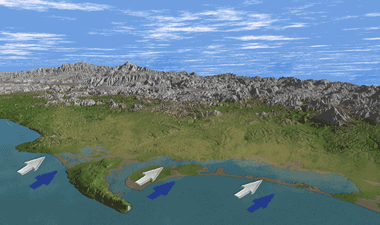
 he
warm inversion layer acts like a blanket on the smog layer, preventing
it from dissipating higher in the atmosphere. Because of high pressure,
areas of California regularly experiences these thermal inversions. The
coastal plain, which is nearly at sea level, often fills at night with
cool heavy air underneath a layer of warmer air. The cool air layer grows
through the night reaching up to 3000 feet thick. Pollutants are trapped
beneath the blanket of warmer air until the sun warms the cool air layer
equalizing the temperature and allowing the inversion to break up and
disperse. he
warm inversion layer acts like a blanket on the smog layer, preventing
it from dissipating higher in the atmosphere. Because of high pressure,
areas of California regularly experiences these thermal inversions. The
coastal plain, which is nearly at sea level, often fills at night with
cool heavy air underneath a layer of warmer air. The cool air layer grows
through the night reaching up to 3000 feet thick. Pollutants are trapped
beneath the blanket of warmer air until the sun warms the cool air layer
equalizing the temperature and allowing the inversion to break up and
disperse.

Rollover the Map to See More
Pollutants are then carried into the mountains on upslope winds on an
almost daily basis during the summer months. In the winter when the sun
angle is lower in the sky, inversions are stronger and longer lasting.
It isn't until a low pressure system moves in with wind and rain that
the stagnant air clears out, lifting the veil of pollution away from the
coastal areas and mountain slopes. Rain and snowfall can clear the air,
but they can also carry pollutants in the form of nitric and sulfuric
acid, dropping them into lakes, rivers, and soil. Hence, air pollution
affects not only the air we breathe, but many terrestrial and aquatic
environments as well.
 Next - Visibility... look into the light...
Next - Visibility... look into the light...
|
Overview
 Air Transport Corridors Air Transport Corridors
 Pollution Sources Pollution Sources
 Criteria Pollutants Criteria Pollutants
 Meteorology Meteorology
 Visibility Visibility
 Acid
Rain/Snow Acid
Rain/Snow
 Air
Pollution Advisories Air
Pollution Advisories
|


